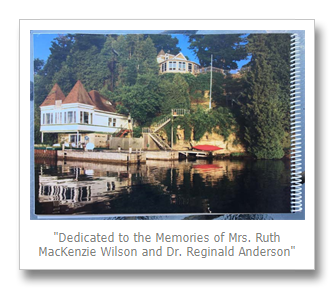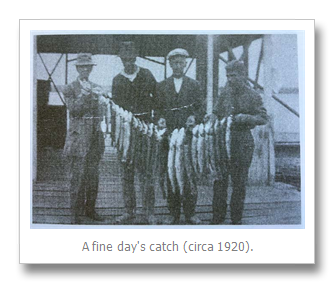Those of us who collect Thousand Islands material – books, pamphlets, post cards and history – will know the thrill I had when I was lent a copy of “Butternut Bay: a Treasured Summer Community”, just before the Holidays.
The first question you ask: “Is the book available in local bookshops?” No, sadly, there were only 200 printed and most were sold to Butternuts, as they are called. But, like me, you may be lucky to find a copy to borrow!
The book, written by the late Dr. Reginald Anderson and his son, Bob Anderson in 2006, describes the history of a group of cottages tucked into the cliffs, between today’s Highway 401 and the St. Lawrence River, only seven miles west of Brockville, Ontario.
The story of how the book came to be is covered in the Introduction. First Dr. Reginald A. explained that capturing the history came about at their Cottage Owners Association Annual Meeting in 1994. Like many communities, the worry that memories may be lost with new generations arriving was uppermost on their minds.
“The idea of this booklet spurred me to write about a great many recollections of the “old days”, which had been lurking in my head for a long time. Thus I began to record a long list of cherished remembrances.” wrote Dr. Anderson. And he went on to thank a number of friends, neighbours and family members. “Many other Butternuts contributed ‘fond remembrances’ and these appear in a separate section. I had known of some of these stories, but others were new to me and I read them with great delight. Thanks to the people who took the time to do so.”
Bob Anderson, Reginald’s son, continued with the introduction, after his father’s death in April 1998, and in 2006 the book was ready for publication. Bob writes, “As most of you know, Dad passed away in April 1998 and, before he died, I promised him that I would complete the research and writing for the “history and cottages” sections which he had begun. I could not have foreseen the time required to fulfill this promise”
For those passionate about history, Bob’s work is appreciated. For the book not only contains cottagers memories, but hard to find history about the early settlement of the region including a full description of the St. Lawrence Central Campground established on 25 acres, which is now Butternut Bay:
Hearing the Call for Religion – a Lack of Churches
Short excerpt: “The Bay of Quinte Conference of the Methodist Episcopal Church of Canada was based in Kingston, Ontario, The authorities of the Conference, concerned about the religious needs of the scattered settlers, developed the following program to alleviate the problem. Saddle-bag preachers, or circuit riders as there were called were sent out usually from Kingston, to ride the woods and forests bringing religion to the scattered farms in the rural area. These pioneer ministers began their travels in 1828 arriving at the various farms on horseback, on average every two months, holding services wherever they could, in the kitchens of farmhouses, in barns, or in any vacant building.
By the 1870’s crude roads had been opened, allowing people to move about more easily. It was evident that saddle-bag preachers were no longer enough to meet the need to bring religion to the region to the growing population. Since there were very few churches in the rural areas, the Church official in Kingston decided to establish a campground where the faithful could gather in the warm summer months, to hold meetings and hear outstanding ministers from the United States deliver fire and brimstone sermons of the type so popular at that time.” (Reference: Letter from Dick Hunt.)
There are six sections to the book:
-
The History of Butternut Bay, by Bob and Reginald Anderson
- The Cottages and Some Cottagers, by Reginald and Bob Anderson
- Stories, Reflections, Musings and Mysteries, by Reginald Anderson
- Fond Remembrances – Contributions from Butternuts
- Closing by Bob Anderson
- Appendices, Land Ownership, A Summary
By far the musing most often talked about after the book’s publishing is, “The Outhouses and Waste Disposal”
For the first several decades of Butternut Bay's existence, none of the cottages had toilets. Obviously, human waste had to be disposed of, and outhouses were not permitted adjacent to individual cottages, because there is insufficient soil depth throughout the property. For many years, there were two banks of small outhouses for designated individual cottages and two large communal outhouses for the others.
The Butternut Bay communal outhouses were not as grand as the "Great Hall of Easement", in the Hampton Court Palace of King Henry VIII, a 28 seater, filled with precious tapestries, but they were, for their day, unusually large and not something found in many other places. There were four or five outhouses located just west of the Hodgkinson property, for the westerly cottages along the cliff, on a promontory nicknamed “Outhouse Point” in its glory years. The view from these privies was unrivaled, but the waste material simply went over the cliff. A second bank of outhouses was located by the creek, below and behind Helen Law’s cottage, with individual privies for the Redmond, Anderson family, Stansfield and Law cottages. Imagine getting out of bed, on a rainy morning, to trudge down the hill to answer nature’s call! The waste, presumably, found its way into the creek and out into the River. No one complained.

The communal outhouses —- one for women, in the woods behind the current Van Raalte cottage and a second one for men, in the woods opposite the current Devaux cottage — were ‘identical, about 20’ x 30’ each, and Jean Bobeau recalls that there were three exterior steps leading up to a doorway and into the interior. On the inside, along both walls, were benches with six holes, or seats, and at each end there was a small closet-like room with a door, for shy folks who wanted some privacy in the privy. Above the benches were three or four open windows, and she does not recall screens, to allow for air circulation. It must have been a thigh-slapping place during mosquito season.

Jean’s story continues with the morning ritual. Every day, at about 10:00 AM, a lucky family member from each cottage would collect “the night soil” from small chamber pots, which were sprinkled throughout each cottage, and consolidate this treasure into a larger pot, usually made of china, with a top and handles. This would then be carried gingerly to the outhouses, to be dumped down one of the holes to dispose of it.
Her memories of this experience are not negative, as you might expect, but extremely positive, for she viewed the outhouse as a gathering place where she could gossip with her neighbours, sitting proudly on one of the open seats. She was never in the men’s outhouse — and never wanted to be — but she’s sure that the same convivial relationships existed there as well.
The outhouses gradually disappeared, as one by one, the cottages began to install toilets. To do this, small collection tanks, with-minimal runs of weeping tiles, were placed in the ground adjacent to the cottages, or, in some cases, the effluent was simply routed into crevices in the rocks. These systems could not come close to today’s standards for septic systems, but they worked reasonably well in those days because the cottages were used only for a few weeks each summer, leaving the ground with ten months to dry up before the next onslaught.
Conclusion
Once I read Butternut Bay, I contacted Bob Anderson who not only gave permission to share these excerpts, but he particularly wanted to pay tribute to Richard 'Dick' Hunt, a former cottage owner.
Dick's work is phenomenally detailed and is critical to telling the story of the nightmarish land holding situation at Butternut Bay. Dick literally devoted years to researching the land holdings, finding many long lost leaseholders and having them agree to cancel the leases. He passed along his research in a series of lengthy letters and I wrote the history of the legal aspects using his letters. It could not have been done without them.
Dick then worked with me and others and our lawyers and surveyors to establish new lot lines for every cottage and get formal agreement from all the cottagers to cancel the dreaded leases. A truckload of documents was taken to Toronto to gain approval for the new survey and lot lines and roads and clear title under a “Judge’s Plan” … and with the stroke of a pen the new plan was accepted. This was the only way this could have been done because we couldn’t comply with Township laws for minimum lot sizes or road widths. It a had taken a century and over $100,000 in fees to unravel this Gordian knot, but an attitudinal renaissance emerged which bred the confidence to invest and upgrade the cottage properties. Virtually all of the 31 cottages/residences at Butternut Bay have been substantially upgraded since the Judge’s Plan was approved in the early 1980's and Butternut Bay has never looked better.
Collecting the stories was the fun part of gathering materials for the book, but the more challenging part was getting the correct facts about the decision by the Methodist Church to create a summer campground to spread the word of God to the farmers along the river and the townsfolk in Brockville and Athens. They took the bold step In the mid 1870's to buy 25 acres at Butternut Bay to create a place where the faithful, or those in need of faith, could attend lengthy services to hear spellbinding saddle bag preachers - the rock stars of the era - deliver the word of the Lord.
The property was purchased, surveyed and divided into small 10' x 20' tent lots, roads were laid out and a cathedral and dining hall/dormitory were built, in the 1880s. They were then open for business and people came by the hundreds by boat from Brockville, or by horse and buggy to attend the services. The leaders thought was that the faithful would pitch their tents and stay a few days during the revival meetings. but the leased tent lots were soon merged into larger lots as the people delighted in the fresh air and the joys of the river and religion began to take a back seat. Before the turn of the century many fine Queen Anne style cottages were built, featuring soaring towers and grand open porches and a number of them have been restored to their former glory with exteriors looking much the same as as they did a century ago.
By Bob Anderson, Butternut Bay, 2017
|
I think you can tell from these short excepts and Bob’s description, that “Butternut Bay: a Treasured Summer Community,” speaks for itself and demonstrates why I am so appreciative for all the effort put forth to capture the history of this small Thousand Islands summer community. I thank them most sincerely.
By Susan W. Smith, Editor
www.Thousandislandslife.com